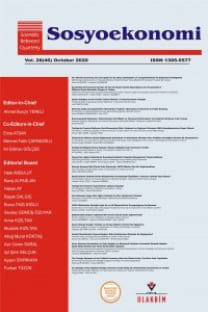Mali Alan Ölçümünde Ostry vd. Yaklaşımı’nın Kuramsal Temeli
Mali Alan, Mali Yorgunluk, Borç Limiti, Ostry vd. Yaklaşımı
Estimating Fiscal Space: The Theoretical Framework of Ostry et al. Approach
Fiscal Space, Fiscal Fatigue, Debt Limit, Ostry et al. Approach,
___
- Bastos, F. & Pineda, E. (2013), “Fiscal Space of Brazilian States”, Inter-American Development Bank Discussion Paper, IDB-DP-310, Inter-American Development Bank, Washington, D.C.
- Blanchard, O. (1990), “Suggestions for a New Set of Fiscal Indicators”, OECD Economics Department Working Papers, 79, 1-34.
- Bohn, H. (1998), “The Behavior of U.S. Public Debt and Deficits”, The Quarterly Journal of Economics, 949-963.
- Bohn, H. (2008), “The Sustainability of Fiscal Policy in the United States”, CESifo Working Paper Series, 1446, 15-49.
- Celasun, O., Debrun, X. & Ostry, J. (2007), “Primary Surplus Behavior and Risks to Fiscal Sustainability in Emerging Market Countries: A “Fan-Chart” Approach”, IMF Staff Papers, 53(3), 401-425.
- Cimadomo, J., Claeys, P. & Poplawski-Ribeiro, M. (2014), “How do Experts Forecast Sovereign Spreads?”, European Economic Review, 1-38.
- Ghosh, A., Kim, J., Mendoza, E., Ostry, J. & Qureshi, M. (2011), “Fiscal Fatigue, Fiscal Space and Debt Sustainability in Advanced Economies”, NBER Working Paper Series, 16782, 1-49.
- Ghosh, A., Kim, J., Mendoza, E., Ostry, J. & Qureshi, M. (2013), “Fiscal Fatigue, Fiscal Space and Debt Sustainability in Advanced Economies”, The Economic Journal, 123, F4-F30.
- Ghosh, A., Ostry, J. & Qureshi, M. (2013), “Fiscal Space and Sovereign Risk Pricing in a Currency Union”, Journal of International Money and Finance, 34, 131-163.
- Hajnovič, F. & Zeman, J. (2013), “Fiscal Space in the Euro Zone”, Narodna Banka Slovenska, 21(2), 9-14.
- Mendoza, E. & Oviedo, P. (2004), “Fiscal Solvency and Macroeconomic Uncertainty in Emerging Markets: The Tale of the Tormented Insurer”, Inter-American Development Bank Discussion Paper, Inter-American Development Bank, Washington, D.C.
- Ostry, J., Ghosh, A., Kim, J. & Qureshi, M. (2010), “Fiscal Space”, IMF Staff Position Note, SPN/10/11, 1-24.
- Şen, H., Sağbaş, İ. & Keskin, A. (2007), Bütçe Açıkları Ve Açık Finansman Politikası – Teori Ve Türkiye Uygulaması, Ankara: Orion Kitabevi.
- Uluslararası Para Fonu (IMF) (2003), “Public Debt in Emerging Markets: Is it Too High?”, World Economic Outlook, 113-152.
- Zandi, M., Cheng, X. & Packard, T. (2011), “Fiscal Space”, Moodys Analytics Special Report, Moody’s Analytics, New York.
- ISSN: 1305-5577
- Yayın Aralığı: Yılda 4 Sayı
- Başlangıç: 2005
- Yayıncı: Sosyoekonomi Derneği
Ticari Dışa Açıklık ve Ekonomik Büyüme Arasındaki İlişkinin Analizi: Türkiye Örneği
Mehmet Vahit EREN, Ayşe ERGİN-ÜNAL
Türkiye Mortgage Piyasasındaki Temerrütlerin ve Erken Ödemelerin Dinamik Analizi
Krizden Demokratik Çıkış: İzlanda Siyasetinde 2008-2017 Arası Gelişmeler
Vergiye Uyum Sürecinde Davranışsal Yaklaşım: Mükellef Davranışları ve Tipolojileri
Serdar ÇİÇEK, Hüseyin Güçlü ÇİÇEK, Elif Ayşe ŞAHİN-İPEK
İngiltere Kamu İç Denetim Sisteminde Merkezileşme ve Devlet İç Denetim Ajansının Kurulması
Güçlü Ekonomiye Geçiş Programı Sonrası Türkiye’de Banka Kârlılığının Belirleyicileri
Cemil ÇİFTÇİ, Dilek DURUSU-ÇİFTÇİ
Ercem ERKUL, Fatma DEMİR-ERKUL
İslam İktisadında Devletin Temel İşlevleri: İnsan Merkezli İktisadi İlkeler
Arif ERSOY, Merve Büşra ALTUNDERE-DOĞAN
İşsizlik ve Büyüme Arasındaki İlişki: Türk İmalat Sanayi Örneği
Özge BARIŞ-TÜZEMEN, Samet TÜZEMEN
